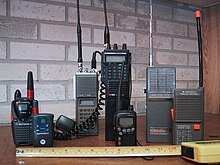
Back راديو مزدوج المسار Arabic Ràdio bidireccional Catalan Duplex radiotransceiver Danish Funkgerät German Raadioseade Estonian رادیو دوطرفه Persian Lähetin-vastaanotin Finnish מכשיר קשר HE Talstöð Icelandic トランシーバー (無線機) Japanese
This article needs additional citations for verification. (July 2022) |


A two-way radio is a radio transceiver (a radio that can both transmit and receive radio waves), which is used for bidirectional person-to-person voice communication with other users with similar radios,[1] in contrast to a broadcast receiver, which only receives transmissions.
Two-way radios usually use a half-duplex communication channel, which permits two-way communication, albeit with the limitation that only one user can transmit at a time. (This is in contrast to simplex communication, in which transmission can only be sent in one direction, and full-duplex, which allows transmission in both directions simultaneously.) This requires users in a group to take turns talking. The radio is normally in receive mode so the user can hear all other transmissions on the channel. When the user wants to talk, they press a "push-to-talk" button, which turns off the receiver and turns on the transmitter; when the button is released, the receiver is activated again. Multiple channels are provided so separate user groups can communicate in the same area without interfering with each other and some radios are designed to scan the channels in order to find a valid transmission. Other two-way radio systems operate in full-duplex mode, in which both parties can talk simultaneously. This requires either two separate radio channels or channel sharing methods such as time-division duplex (TDD) to carry the two directions of the conversation simultaneously on a single radio frequency.[2]
The first two-way radio was an AM-only device introduced by the Galvin Manufacturing Corporation in 1940 for use by the police and military during World War II, and followed by the company's 1943 introduction of the Walkie-Talkie,[3] the best-known example of a two-way radio.[4]
- ^ Graf, Rudolf F. (1999). Modern Dictionary of Electronics, 7th Ed. Elsevier. p. 811. ISBN 9780080511986.
- ^ Goldsmith, Andrea (8 Aug 2005). Wireless Communications. Cambridge University Press. ISBN 9780521837163. Retrieved 20 April 2016.
- ^ Hall, Mark (October 3, 2022). "Motorola, Inc.". Encyclopædia Britannica. Archived from the original on January 18, 2023. Retrieved January 17, 2022.
- ^ Cite error: The named reference
CrystalRadiowas invoked but never defined (see the help page).